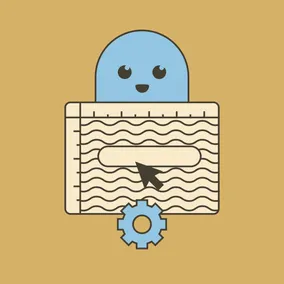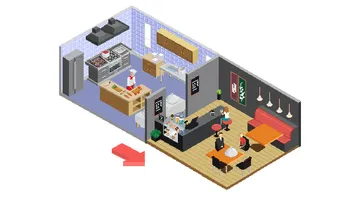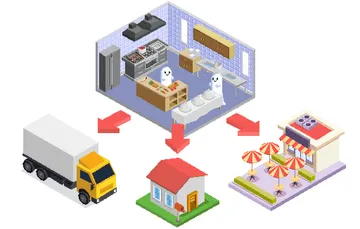What is a Headless CMS and When Should I Use One?

Understand the benefits and challenges of a headless CMS, and learn when it’s the right choice for your business needs.
When starting a new project, decision makers are faced with the dilemma of choosing a content management system (CMS). Sometimes, it’s not that simple and they must choose whether to go with a traditional CMS or a headless CMS. Both offer unique benefits and cater to different needs, making it crucial to understand when each makes sense for your project. Let’s take a look at some considerations that can help you make the right decision.
What is a Traditional CMS?
Traditional CMS’s – like Craft CMS, WordPress, and Drupal – offer a pre-packaged solution for content creation, management, and delivery. They include powerful interfaces with content editing capabilities and templating out of the box, enabling you to create sites with ease. A traditional CMS can be monolithic because the back-end and front-end are tightly coupled. Using a traditional CMS typically means you are using all of the tools included to achieve your goal.
What is a Headless CMS?
A Headless CMS is like a Traditional CMS in that it includes content creation and management tools. But it differs in the fact that the back-end content management system is decoupled from the front-end (presentation layer), allowing developers to use any technology stack they prefer for building the front-end of the site. The back-end acts as an API with its only purpose being to serve content from the database. There are CMS options like Contentful, Payload, and Strapi that are built to be headless. Popular traditional CMS’s like Craft CMS and WordPress also offer headless variants.
The Restaurant Analogy
Let’s simplify things a bit more and look at the decision using an analogy; a restaurant.

Traditional Restaurant (Traditional CMS)
Imagine a restaurant where the kitchen and dining room are connected. The chefs cook the food, and the waitstaff serve it directly to the customers in the same building. This setup means that everything is closely integrated, and the kitchen (back-end) is tightly coupled to the dining experience (front-end). Picture a scenario where the restaurant decides to change from table service to buffet style. The food now needs to be prepared in advance and delivered to the front of house in a different way, potentially even requiring new equipment. The restaurant needs to be reconfigured to not only accommodate the buffet but also to interface with the kitchen differently. Because the restaurant and kitchen are coupled, both sides would require work in order to accommodate a shift in strategy.

Ghost Kitchen (Headless CMS)
Now, think of a ghost (or cloud) kitchen where food is prepared centrally but can be delivered to various locations or dining experiences. The kitchen (back-end) focuses solely on cooking (content creation and management) and doesn't worry about where the food is served. Instead, the meals (content) can be delivered to different endpoints like food trucks, home deliveries, or partner restaurants (or in our case websites, mobile apps, etc.). This separation allows more flexibility in how and where the content is delivered without changing the core cooking process. If a new experience requires new equipment or processes, the kitchen can be expanded without affecting the front-end experience.
When to Use a Headless CMS
Omni-Channel Content Delivery
If you consistently need to deliver content across multiple platforms (websites, mobile apps, IoT devices), a headless CMS is ideal because it can serve the same content through APIs to any front-end. The front-end can be swapped out without any need for development to the back-end.
Scalability and Flexibility
If you want the ability to keep your content management system up-to-date independently of the presentation layer, a headless CMS can allow for more agile and scalable development. This could be especially useful if you anticipate needing to redesign or update parts of the front-end frequently without affecting the back-end content.
Front-end Framework Preferences
Maybe your team has developers who are very proficient in a particular JavaScript framework, like Next.js, SvelteKit, or Astro. The time needed to learn a new templating language could push you past your deadline. Maybe you have some cool interactive interface in mind? A headless CMS can provide the raw content for your developers to build highly custom, tailor-made front-ends in whatever language or framework they please.
Security
Going headless can offer security advantages due to its decoupled nature. By communicating via API to the front-end, data access can be controlled more granularly. Because the back-end is only responsible for content management and delivery, fewer plugins are typically used which means a smaller chance of vulnerabilities due to third-party software.
Hosting & Infrastructure
A cloud-based headless CMS offers additional advantages over a self-hosted headless CMS. It can simplify maintenance and operating costs since the cloud provider is responsible for updates and security of the platform. Cloud-based solutions like Strapi Cloud often come with integrated security features, automatic backups, and disaster recovery options.
Which will you choose?
While the flexibility and security a headless CMS offers may be great benefits, it may not be necessary for every project and could even introduce complexity. It’s important to consider the long-term purpose of the project and who will be responsible for maintaining it as well as authoring content. If your primary focus is on managing and delivering content in a structured manner with rapid development, a traditional CMS can be an excellent choice. But if you feel any of the examples I’ve laid out above align with your project’s requirements then a headless CMS may be right for you!
Whatever route you take, remember that both Craft CMS and WordPress can be used in traditional or headless applications and are a fine choice either way! Now you know the differences between a traditional and headless CMS, and an informed decision can be made. If you have more questions or a project you think could benefit from a traditional or headless CMS, we’d love to help!
